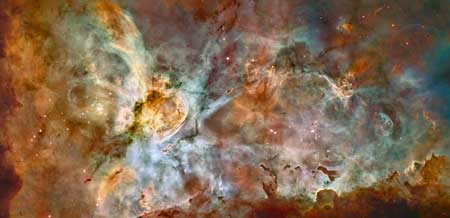Astronomers don’t fully understand how the galaxy’s most massive stars form, but a new simulation sheds light on the process of stellar birth.

NASA / ESA
If you’ve ever tried to feed a toddler, you know they push away food as often as they eat it — yet they manage to grow at prodigious rates.
Massive stars aren’t so very different. As infants, these stars ignite nuclear fusion before they’ve even finished accreting all their surrounding gas, and the ensuing brilliance pushes away the very gas they need to grow.
Still, we see massive stars, even ones more than 100 times the mass of the Sun, scattered throughout the Milky Way. So they get the job done — but how? In a presentation given at the 229th meeting of the American Astronomical Society in January, Anna Rosen (University of California, Santa Cruz) presented an answer to that question: finger food.
Stars more than eight times the mass of the Sun make up just 1% of our galaxy’s stellar population, but what they lack in numbers they make up for in power: their intense radiation exerts physical pressure, pushing away surrounding gas. The brilliant light also destroys dust and even splits nearby atoms into their component protons and electrons. Not to mention the spectacular detonations that mark the end of their lives. The feedback from growing and dying massive stars governs the evolution of galaxies.
Star in a Box
To make sense of these far-reaching effects, theorists such as Rosen are in the process of simulating massive stars’ lives (and deaths). The task is enormous and strains available computing power, so theorists must simplify down to the bare necessities as much as possible. But as the field advances, theorists are working to make simulations as true-to-life as possible.
For example, even though the pressure exerted by a star’s radiation dominates the dynamics of gas feeding the infant star, possibly even halting it altogether, no simulations have fully accounted for the effect of radiation pressure until now.
That’s where Rosen’s work comes in: she has simulated stellar birth amidst a turbulent clump of gas, taking into account both the star’s intense radiation field as well as the radiation from dust and gas that reradiates the star’s own light at longer wavelengths. The simulations are published in the Monthly Notices of the Royal Astronomical Society (arXiv preprint).
The results are fascinating to watch (this simulation is 40,000 astronomical units on a side):
Zoom in for a closer look (this simulation is 12,000 astronomical units on a side):
Even as the star’s radiation pressure pushes out big cavities, gas still flows in through an extended accretion disk surrounding the star. But that’s not the only way the star feeds. Look closely and you’ll see that amidst the turbulent roil, tiny fingers of gas that were initially traveling outward manage to thread their way back, delivering chunks of gas to the growing star.
These fingers are known as Rayleigh-Taylor instabilities, and even if you don’t study star formation for a living, you’ve probably seen them before. They occur whenever a heavier fluid lies on top of a lighter fluid — the heavier fluid wants to fall down because of gravity, and the lighter fluid wants to buoy up. You can see the swirling results of this instability whenever you pour milk into coffee:
Growth by Instability
A key advance in this simulation is resolution. In previous work, low resolution smoothed away small-scale changes, preventing instabilities from forming in the first place. In Rosen's simulations, the higher resolution not only allows a closer-in view of the forming star, it also enables those small-scale structures to form and grow in size.
That said, there's still work to be done: Rosen says this simulation doesn't include winds or outflows from the forming star — and there are bound to be some — and it ignores magnetic fields. There's still a ways to go before even state-of-the-art simulations become true-to-life.
What's really neat, though, is that other astronomers may already have spotted the instabilities this simulation predicts.
Back in 2013, Nanda Kumar (University of Porto, Portugal) discovered what look like Rayleigh-Taylor features in Very Large Telescope observations of a region that’s forming massive stars. These features, published in Astronomy & Astrophysics, are on the scale of thousands of astronomical units (a.u.) — much larger than those seen in Rosen's simulation. However, since these kinds of instabilities typically start at small scales and then grow steadily larger, it could be that Kumar has indeed spotted the very phenomenon that Rosen simulated.
Read about forming massive stars in the October 2015 issue of Sky & Telescope, and subscribe for more in-depth features in astronomy.
 3
3









Comments
tom-dasilva
January 27, 2017 at 3:30 pm
add angular momentum. Should be easy enough.
You must be logged in to post a comment.
Bob
January 27, 2017 at 11:39 pm
Monica Young...
Really liked the Rayleigh-Taylor Instability video and the easy to understand mini-lecture. And I enjoyed the music during the credits at the end. Fantastic!
Bob Patrick
Kentucky
You must be logged in to post a comment.
P.Michael-Hutchins
January 30, 2017 at 8:19 am
"The task is enormous and strains available computing power": amusing that that exact statement could have been made at any time since the advent of fingers.
You must be logged in to post a comment.
You must be logged in to post a comment.